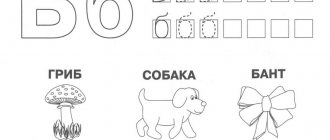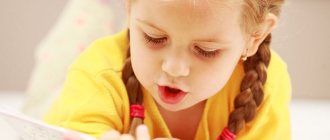Sound [and]. Letter I, and
PREDICTED RESULTS:
• children will become familiar with the vowel sound [and], learn to distinguish this sound in words;
• become familiar with the capital I and the small letter I and understand their purpose;
• learn to observe the sound of a consonant sound in a merging syllable with the vowel sound [i] and vowels [a], [o];
• will continue to learn competent syllabic-sound analysis of words;
• consolidate knowledge about the syllabic-forming role of vowel sounds, in particular the sound [and];
• learn a coherent retelling of a short text.
DURING THE CLASSES
1. Updating knowledge
— What sounds did we get acquainted with in previous lessons? What were those sounds? What characterizes vowel sounds? Today we will get acquainted with a new sound. We will find out which group of sounds it will fall into by the end of the lesson.
2. Motivation for learning activities
- Listen to the proverb: It’s good to teach someone who wants to know everything.
You and I work very hard in every lesson, and I want to tell you a lot of interesting, funny, kind, smart things. Let's work together, actively raise our hands, and share our knowledge with friends. Then everyone will be in a good mood.
Today we will go to the Wonderful Land of Fairy Tales. Remember the fairy tales that we met earlier. Name the most terrible and cruel hero from A. N. Tolstoy’s story “The Golden Key...”. The diagram will help you.
- Who is this? (Karabas-Barabas.)
Divide the hero's name into syllables.
Which hero flew to the distant land of Limpopo to help poor hippos? Divide the word into syllables.
- Which bird in one fairy tale was stupid, gullible, really loved grains of wheat and millet and because of this got into unpleasant situations, it was even almost eaten? In another fairy tale, the same bird was brave, wore a braid on its shoulders and protected poor and unfortunate animals. Who is this?
- What smart and prudent boy could not drown in a pond, but, after swimming in the water, climbed out onto a water lily leaf and received an amazing thing as a gift? Who is this?
Which letters helped us cope with all the tasks in the Wonderful Land of Fairy Tales. (Letters A, o and O, o.)
What sounds do they represent? (Sound [o] and sound [o].)
Describe the sounds [a] and [o].
Guess the name of fairy-tale characters by the first sound of their name.
The letters are voiced by reading children.
Words for reference: Barmaley, Pinocchio, Cockerel - Golden Scallop. Hare, Wolf, Masha, Bear, Aibolit, Fox, Emelya, Cinderella, Thumbelina, Snow Maiden, etc.
3. Work on the topic of the lesson
— Look at the illustration for the fairy tale “Ivan Tsarevich and the Gray Wolf.”
Name the hero of the fairy tale who approached a huge oak tree and saw a chest high on a branch. The bear tore out the oak tree. The chest fell and broke. A hare ran out of it. The wolf caught up with the hare. A duck flew out of the hare and soared into the sky. The eagle overtook the duck. The duck dropped the egg into the sea. Our hero sat down on the shore and spun around. He can't save his bride. Suddenly a pike swam out of the water with an egg in its teeth. Our hero was delighted, took the egg, cracked it open and took out the treasured needle from the egg. He broke the tip of the needle and Kashchei the Immortal died. That's the end of the fairy tale. Well done to those who listened. What is the name of the hero of the fairy tale? (Ivanushka, Ivan.)
Divide the word Ivan into syllables. Say the first syllable. How many sounds do we hear in this syllable? How to pronounce it? (Long, drawn-out, easy, meets no obstacles.)
What sound do you think this is? Give him a description. (The sound [i] is a vowel. It stretches well. When pronounced, it does not encounter obstacles.)
Name the second syllable. (Syllable -van.)
How many sounds does it have? Is there a syllable merger here? Pronounce the word so that the stress in the word is clearly heard. (Iva-a-an.)
Which vowel is stressed? Which vowel is left unaccented? But the sound is still heard well. How did Ivanushka cope with Kashchei the Immortal? Say the name of the object in which Kashchei's death was hidden, syllable by syllable. (Needle.)
Isolating the sound from the word needle on p. 29.
Working with the diagram.
- Complete the tasks at the top of the village. 30. Match the pictures with the diagram.
Working with the meaning of a word.
— What are the needles on spruce trees called? (Needles, needles.)
Name the first syllable. What sound do you hear? Describe this sound. What sound is this? (Sound [and]).
Listen to V. Berestov’s poem (p. 29) and find objects whose names contain the sound [and].
Isolating the sound [i] from the word willow.
Working with the word scheme.
The designation of a sound by the letter I, i.
Listen to the poem. What words begin with the sound [and]?
Above the talkative river
The willow tree is waiting to visit us.
We need a timid oriole
See it at least once! (M. Yasnov)
- Say the words willow, oriole syllable by syllable, highlight with your voice the syllable that contains the sound [and]. Make diagrams. Describe the sound [and]. (The sound is a vowel. It forms a complete syllable. In these words it is a stressed vowel sound.)
Listen to the advice of the poet E. Uspensky.
Let's quickly take needles and glue,
Threads, spools and repairing toys.
And we thank you for it from the bottom of our hearts
The kids will thank you.
— What subjects did the older children take? (Needles, threads, spools, toys.)
Where in words do you hear the sound [and]? (And-nails, and-toys.)
What is the last syllable in these words? (Syllable -ki.)
How is a consonant sound next to the sound [and] pronounced and heard? (The sound [k] is heard softly.)
We say needles and toys when there are a lot of these items. Try to name these items when they are one at a time. (Needle, toy.)
Say the last syllable. (Syllable -ka.)
How is a consonant sound heard when it is followed by the sound [a]? (The sound [k] is heard firmly.)
Say other words that we found in the poem. (Threads, spools.)
Say the words syllable by syllable. Name the merger syllables. (These are the syllables -ni, -ki.)
What do consonant sounds sound like when we hear the sound [and] after them? (Consonant sounds are heard softly.)
What else have we learned about sound [and]? (That it forms a syllable.)
What distinguishes the vowel sound [i] from the vowel sounds [a] and [o]? (In merging syllables, the consonants are read firmly with the sounds [o] and [o].)
What unites them? (They are vowel sounds.)
What letter represents the sound [and]? (Letters I and and).
What do these letters look like? (Children come up with the image of objects similar to the letter I.)
Listen to how V. Stepanov wrote about the letter I.
Look at the gate:
Why is she not the letter I?
Between two straight boards
One lay diagonally.
- When do we use capital letter I? The illustration in the textbook will help you (p. 28). (In the word I-vanushka.)
When do we use small letter and? (In the words i-golki, gu-si, house, mushrooms, spruce, hut.)
Find on page 28 objects whose names contain the sound [i]. Name the syllable with the sound [i]. (Geese-swans (si, di); hut (from); willow (and); spruce (li); Ivan (I); boots (gi).)
Find the letters that represent the sound [and], type I, and.
What fairy tales helped us in selecting objects with sound [and]? (“Ivan Tsarevich and the Gray Wolf”, “The Frog Princess”, “Geese and Swans”.)
Below the illustration is a diagram of the proposal. Make a proposal for her. (Ivan Tsarevich is looking for a bride. Ivan Tsarevich is looking for an arrow. Geese-swans are guarding the boy. Geese serve Baba Yaga.)
What sound does an arrow shoot by Ivan Tsarevich make? (Ee-e-e-e-e.)
Sometimes in fairy tales, when heroes turn to old, elderly people with a question to show them the way somewhere, they are answered like this: “..., (E-and-and!) dear, this is very far away. Here’s a ball (or mushroom) that will lead you to your cherished goal.”
Do you think there could be good, kind heroes in the illustration (p. 28)? And where? (The boy Vanyusha is in the hut. He is guarded by geese-swans. Alyonushka is wandering somewhere in the forest. She is looking for her brother.)
Will the sister be able to save her brother? Who will help her with this? (Stove. River. Apple tree.)
— How do all Russian folk tales end? (In fairy tales, good triumphs over evil.)
Listen to the riddle.
A thin thread is threaded into the narrow eyelet
And she quickly swam after the boat.
He sews, sews up and injects sharply,
And they call it a boat... (Needle)
- Why does a person need a needle? (For sewing.)
A person can sew, saw, cut, plane, hammer something. What things help a person in his work? (A person is helped in his work by a hammer, pliers, scissors, an awl...)
Name these items in one word? (Tools.)
What is the first sound? (Sound [and].)
Pronounce this sound, articulating correctly [i-i-i]. (The mouth is open with a narrow slit. To pronounce the sound [and], you need to stretch your lips in a smile, press the tip of your tongue against the lower teeth from the inside.)
Remember what sounds and letters we have already learned? Read the syllables that merge with the sound [i]: li; mi; ti; chi; ki. How are consonants pronounced? Read the syllables again and add your own syllable to make a complete word.
For example, the teacher reads the syllable li. Children add: sa, pa, ra, ga, ka, for.
On the letter tape, read the letters you have learned. What sounds do they represent? (Sounds [o], [o].)
Can we put the letter next to them too? (No, why?
Answer any of my questions with a word that begins with a familiar sound: [a], [o], [and]. Who heals animals? (Aibolit.)
What was the name of Doctor Aibolit's dog? (Abba.)
What was the name of the girl with blue hair's poodle? (Artemon.)
What was the name of the fox who took the money from Pinocchio? (Alice.)
What flowers did you bring to school on September 1? (Asters, pansies, amaryllis...)
What book will teach us to read and write? (ABC.)
Now let's change the sound. Also answer the questions with one word that begins with the sound [o]. The name of which month begins with the sound [o]? (October.) From the sound [and]? From the sound [a]?
Name the chick of the proud bird that lives high in the mountains. (Orlik.)
What insects' names begin with the sound [o]? (Wasps.)
Who is Eeyore? (Donkey.)
On what background of the letter strip will we put the letter and? Which row? Why?
4. Reflection on learning activities
— What new did you learn in the lesson?
What new sound were you introduced to? (With the sound [and].) What is that sound? How is it different from the sounds we studied before? How are consonants read with this sound? Make a diagram for the word needles. Indicate which of these is a confluence syllable?





